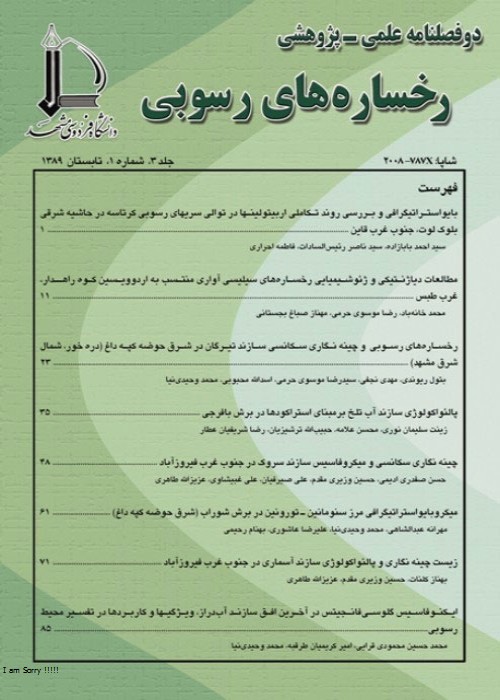Sedimentary facies and origin of carbonate deposits of the Reeg estuary (northern of the Persian Gulf)
Author(s):
Article Type:
Research/Original Article (دارای رتبه معتبر)
Abstract:
IntroductionThe Reeg estuary is an important coastal sedimentary environment in the north of the Persian Gulf that is located at the west of the Boushehr Province (Gharibreza, 2005). This basin shows morphology of the bar built estuary and includes three main sections of riverine, lagoon, and marine which is separated from land by the fossil beach. The Reeg estuary is an example of a retrogressive coast that is emerged by sea level fall since Late Quaternary (Gharibreza et al., 2002; Lak et al., 2010). This estuary might be a suitable coastal environment to collect carbonate mud and calcareous oolitic sands assuming similarities between south and north of the Persian Gulf. Determining of Reeg Estuary sediment sources especially carbonate mud and oolitic sands and identification its sedimentary facies were the aims of present research.
Materials and MethodsA comprehensive sediment sampling plan and laboratory analysis were implemented to test the research assumption. Forty-eight sediment samples were taken from different sedimentary facies of the sink and source areas. Thin section of 24 sandy texture samples of the sink and source areas were studied by binocular microscope to identify source of coarse-grained sediments. Composition of sediment was studied using Folk and Ward (1957) method. Distribution of sedimentary facies was studied using geographical information system tools which is widely used around the world (Heap, 2004).
Results and DiscussionCalcimetry tests showed that carbonate content of fine-grained sediments in lagoon section is more than 50%, which was emphasized to suitable chemical conditions for accumulation of carbonate mud. The mean content of the rock fragments, feldspar, and quartz particles were obtained 77±11%, 14±8%, and 9±6%, respectively. Resultant data showed significant profusion of calcareous rock fragments in sediments in both sink and source areas, which represents the Calclithite class of composition. Results also revealed that oolitic sands are the main constituents of marine facies (≈ 90%) particularly along the recent barrier island. In addition, Bakhtiary and Aghajari formations and coarse-grained strata of old and young terraces are the origin of coarse sediments which have been deposited in the Reeg Estuary. Once again, capability of the northern Persian Gulf's coastal sedimentary environments for deposition of carbonate sediments like as what has reported from the southern coasts was proved by present research.
AcknowledgementThe research was supported by Soil Conservation and Watershed Management Research Institute (SCWMRI), Tehran, Iran. The author gratefully acknowledges all academic staffs of coastal protection department for their helps on the implementation of this research.
Materials and MethodsA comprehensive sediment sampling plan and laboratory analysis were implemented to test the research assumption. Forty-eight sediment samples were taken from different sedimentary facies of the sink and source areas. Thin section of 24 sandy texture samples of the sink and source areas were studied by binocular microscope to identify source of coarse-grained sediments. Composition of sediment was studied using Folk and Ward (1957) method. Distribution of sedimentary facies was studied using geographical information system tools which is widely used around the world (Heap, 2004).
Results and DiscussionCalcimetry tests showed that carbonate content of fine-grained sediments in lagoon section is more than 50%, which was emphasized to suitable chemical conditions for accumulation of carbonate mud. The mean content of the rock fragments, feldspar, and quartz particles were obtained 77±11%, 14±8%, and 9±6%, respectively. Resultant data showed significant profusion of calcareous rock fragments in sediments in both sink and source areas, which represents the Calclithite class of composition. Results also revealed that oolitic sands are the main constituents of marine facies (≈ 90%) particularly along the recent barrier island. In addition, Bakhtiary and Aghajari formations and coarse-grained strata of old and young terraces are the origin of coarse sediments which have been deposited in the Reeg Estuary. Once again, capability of the northern Persian Gulf's coastal sedimentary environments for deposition of carbonate sediments like as what has reported from the southern coasts was proved by present research.
AcknowledgementThe research was supported by Soil Conservation and Watershed Management Research Institute (SCWMRI), Tehran, Iran. The author gratefully acknowledges all academic staffs of coastal protection department for their helps on the implementation of this research.
Keywords:
Language:
Persian
Published:
Sedimentray Facies, Volume:8 Issue: 2, 2016
Pages:
216 to 235
https://magiran.com/p1778810
مقالات دیگری از این نویسنده (گان)
-
Estimating the Volume of Debris Flows along the Sijan Stream Using Topographic Surveys and CIVIL 3D
Rouhangiz Akhtari *, Majid Zareei,
Journal of Environment and Water Engineering, -
Zoning of Tidal Facies a Prerequisite of the Integrated Coastal Zone Management of Bushehr Province (Iran)
*, Mohammadreza Allahyar, Hamid Khalili, Rasool Ghanbari Moman
Journal of Marine Engineering,



